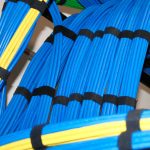5 Air Blown Fiber Optic Network Design Considerations
Air blown fiber optics can save you money over the course of two installations as your facility grows and expands. It’s scalable and convenient, with less downtime during the installation, giving your facility the extra telecommunication infrastructure it needs to future-proof your business.
Look over our guide to the five main considerations you need for air blown fiber optic cable installation.
1. Choosing Appropriate Fiber Optic Cables
You’ve got two main options with fiber optic cables. Single-mode cables are ideal for long-distance communication. Multi-mode fiber optics are better for shorter distances. When we mean long distances, it’s 1 mile or more. We’ll assess your facility to see what cable works for you.
2. Ducts, Connectors, and Routing of Cables
Based on the layout of your facility, we need to design the right pathways for air blown fiber optics to make sure they reach the right areas. We’ll also assess if the pressurized air can travel through the ducts correctly.
For connectors, we’ll look at how many turns the ducts need to make, such as when they go from walls to ceilings and vice-versa. Too many turns can cause difficulties with the air pressure.
For routing, air blown fiber generally works best with distances between 3,000 and 6,000 feet. We may need to set up multiple blowing machines to make this happen to make sure the cables reach their destinations.
3. Calculating Network Capacity
The capacity of an air blown fiber network is typically measured in terms of its total bandwidth. We take into account the number of fibers, type of fiber, length of the network, and the type of transmission equipment. More fibers, single-mode cables, and shorter networks (in general) lead to higher bandwidth and less signal loss.
The general formula we use is this:
Capacity = (Bandwidth per fiber) x (Number of fibers) x (Length of the network)
4. Optimization of Network Performance
We’ll also optimize the network performance by assessing several factors, including:
- Proper installation of microducts and fiber
- Minimizing bends in the cable
- Proper termination of cables
- Equipment used for information transmission
- Monitoring latency once the network is fully operational
5. Duct or Microduct Selection
The type of duct or microduct selected will depend on the intended use and the cable size. Larger cables will require larger ducts or microducts. Typically, we try to use the smallest possible microducts because those are easier to install within a facility, and the air pressure can be regulated more effectively. But it depends on your building’s infrastructure.
Contact CKC Data Solutions for a Consultation
Ready to take your business to the next level? The experts at CKC Data Solutions can design and install air blown fiber optic cables to future-proof your telecommunications needs.Contact us or call (417) 812-5251 to start the conversation.




